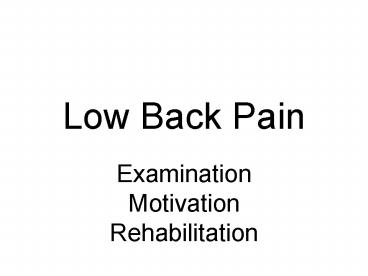Low Back Pain - PowerPoint PPT Presentation
1 / 30
Title:
Low Back Pain
Description:
... Low Back Pain: Greenough CG et al 1989 Spine 14 pages 947-955 ... Spine Movements. Side Flexion Standing. Vs. Side Flexion Sitting. Straight Leg Raise Test ... – PowerPoint PPT presentation
Number of Views:498
Avg rating:3.0/5.0
Title: Low Back Pain
1
Low Back Pain
- Examination Motivation Rehabilitation
2
Kennedy F. 1946 The mind of the injured worker
its effects on disability periods. Compensation
medicine volume 119-21
3
Is compensation involved?
- Miller H. 1961
- Accident Neurosis British Medical Journal vol 1
919-925 - Cure by verdict
4
The Effects of Compensation on Recovery from Low
Back Pain Greenough CG et al 1989 Spine 14
pages 947-955 five years after settlement- still
a massive difference
5
Waddell G 2004 The Back Pain Revolution, second
edition. Churchill Livingstone, New York
- although he acknowledges that compensation
patients respond less well to PMP and
rehabilitation - methodological flaws in many studies
- samples small
- patients highly selected with poor diagnostic
criteria - poor follow-up
- failure to allow for other factors such as job
demands - differences are small
6
Occupational Perspectives Section 5 pages 331-2
in Main CJ et al 2008 Pain ManagementElsevier,
Edinburgh
7
Main C.J. Pain Management
- video evidence questionable because
- offers only samples
- samples may not be representative
- usually unable to replicate the actual physical
demands of work - does not capture the after effects of exertion
8
Spine movements
- Forward Flexion
9
Spine Movements
- Forward Flexion Standing
- Vs
- Forward Flexion Sitting
10
Spine Movements
- Side Flexion
11
Spine Movements
- Side Flexion Standing
- Vs
- Side Flexion Sitting
12
Straight Leg Raise Test
13
Straight Leg Raise Test
- How gross a restriction is allowed?
- Bilateral should be less ltd than unilateral
- Bilateral vs sitting with knees extended
14
Neurological
- Calf Muscle Power
15
Neurological
- Calf muscles tested lying
- Vs
- Standing
16
Neurological
- Quadriceps Power
17
Neurological
- Quads tested lying
- Vs
- Standing
18
Neurological
- Psoas Power
19
Neurological
- Psoas tested lying
- Vs
- Sitting
20
Neurological
- Tibialis Anterior Power
21
Neurological
- Tibialis Anterior Lying
- Vs
- Tibialis anterior Standing (by heel-walking)
- Vs
- Tibialis Anterior Sitting (one at a time then
both together)
22
Neurological
- Peronei Power
23
Neurological
- Peronei tested each side separately
- Vs
- Both together
24
Hip Movement Test
- Bilateral Passive Hip Flexion
25
Hip Movement Test
- Bilateral passive hip flexion tested face up
- Vs
- Face down
26
Inconsistancies found
- So what?
27
Inconsistancies FoundWe can accept all the
loose ends and inexplicable featuresWe dont
organize the next round of expensive and
counter-productive investigations/third opinions
28
What do we tell the patient?
- You are completely mad and I will arrange for you
to be admitted sraight away to a psychiatric
hospital
29
What do we tell the patient?
- Your back is sound.
- Your pain receptors are over-reacting reporting
damage and danger incorrectly
30
The way forward
- Between us we can switch these pain receptors
off. - But you may have to do the hard work































